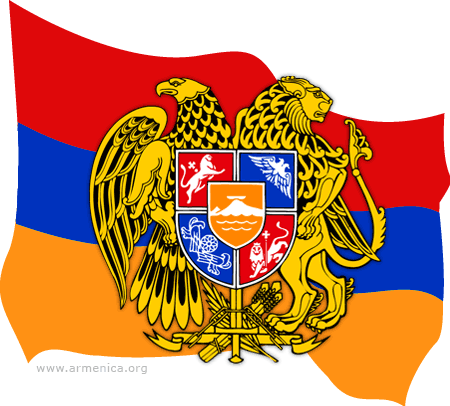
|
| Flag and Coat of Arms |
| Point at the different parts of the flag or the coat of arms in order to read the symbolic value of a specific detail. |
| Red |
| The red color of the flag symbolizes the shed blood of the Armenian people through out of the history, protecting the survival of the Armenian nation, its Christian faith and the sovereignty and independence of Armenia. |
| Blue |
| The blue color symbolizes the striving for an Armenian nation under the free, tranquil and peaceful sky. It also stands for the reflection onto the waters of the rivers and lakes that have given life and prosperity to Armenia. |
| Orange |
The orange color symbolizes the golden fields of wheat, the industrious spirit of the Armenian nation and its prosperity.
In the original suggestion in 1918, the flag of the last Armenian dynasty, the Roubinian, was chosen consisting of the colors red, blue, and yellow. The Yellow was, however, replaced with orange giving the flag a more harmonious color composition.
|
| Eagle |
The eagle is holding up the one side of the shield containing the arms of the four Armenian royal dynasties guarding the holy Mount Ararat, the symbol of the Armenian nation, in the middle.
The eagle was a part of the older Armenian royal dynasties of Artashisian and Arshakouni.
|
| Lion |
The lion is holding up the one side of the shield containing the arms of the four Armenian royal dynasties guarding the holy Mount Ararat in the middle.
The lion was a part of the later Armenian dynasties of Bagratouni and Roubinian.
|
| Ararat |
The holy Mount Ararat is the symbol of the Armenian nation. On its peak rests Noah's ark which according to the Bible stranded on Mount Ararat after the Great Flood.
Ararat is guarded by the arms of the four royal dynsaties of Armenia. |
| Bagratouni Dynasty |
This is the arms of the third Armenian royal dynasty, the Bagratouni, who ruled Armenia between 862 and 1045 A.D.
Ani, the "City of 1001 churches", was the magnificent capital of Bagratouni kingdom.
|
| Arshakounian Dynasty |
This is the arms of the second Armenian royal dynasty, the Arshakouni, who ruled Armenia between 53 and 423 A.D.
The Arshakouni (Arsacid), was a side branch of the Persian royal family (Persian "Ashkani"), and survived the main Persian branch for two centuries.
It was during the reign of this dynasty that Armenia, as the first nation in the world, adopted Christianity as official state religion in 301. The Armenian alphabet was also created during their reign, in 405.
|
| Artashisian Dynasty |
This is the arms of the first Armenian royal dynsaty, the Artashesian, who ruled Armenia between 190 and 12 B.C.
|
| Roubinian Dynasty |
This is the arms of the fourth Armenian royal dynasty, the Roubinian, who ruled the Armenian Cilicia on the Mediterranean coast between 1187 and 1375 A.D.
The Cilician Armenia emerged after the invasion of the Armenian Highland by Seljuk Turks, and the emigration of the Bagratid Prince Rouben accompanied by a number of other Armenian princes and their people to Cilicia on the Mediterranean coast. The Armenian Cilicia became an important ally for the crusaders.
|
| Sword |
| The sword breaking the chain represents the strength of the nation and the struggle for freedom, cutting the chains of oppression. |
| Feather |
| The feather represents the intellectual and cultural heritage of the Armenian People. |
| Bundle of Wheat Flowers |
| The bundle of wheat flowers represents the industrious nature of the Armenian People.
|
| Broken Chain |
| The broken chain symbolizes the struggle for freedom and independence. |
| Ribon |
| The ribbon represents the tricolor flag of the Republic of Armenia. |
|
The flag and coat of arms of the present Republic of Armenia are those adopted by the first Armenian republic in 1918-1920. The coat of arms was designed by member of the Russian Academy of Fine Arts, Architect Alexander Tamanian (creator of Yerevan's city plan) and artist Hakob Kojoyan.
In order to read about the symbolic values of the details, point to the different parts of the flag and the arms in order to display the corresponding discription text.
|
|
|
|

